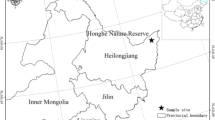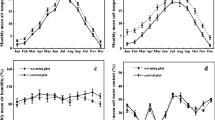Abstract
Freezing–thawing cycle (FTC) is an important environmental factor affecting soil physicochemical properties and microbial activities. The effects of FTC at mid-high latitudes, especially in the permafrost regions impacted by global warming, have become a hot topic for research. However, the responses of active organic carbon fractions and soil enzyme activities to FTC in the active layers of permafrost regions remain far from certain. In this study, soil samples from three soil layers of (0–15, 15–30 and 30–45 cm) an undisturbed peatlands in Da Xing’anling Mountains, Northeast China, were collected, and then subjected to various FTCs with a large (10 to −10 °C) and a small (5 to −5 °C) amplitudes, respectively. Results showed that the soil active organic carbon fractions and enzyme activities were sensitive to FTCs. The FTCs significantly increased water-extracted organic carbon (WEOC) concentration in the three soil layers by approximately 5–28 % for the large amplitude and 22–36 % for the small amplitude. In contrast, FTCs significantly decreased microbial biomass carbon (MBC) concentration, cellulase, amylase and invertase activities. Overall, the damage of FTCs to soil enzymes was severe at the deeper soil depths and for the large amplitude. Interestingly, the soil WEOC concentration was lower at the large amplitude of FTC compared with the small amplitude. When the numbers of FTCs increased, WEOC concentration began to decrease and MBC concentration and enzyme activities began to increase. In addition, the significant correlations between active organic carbon fractions and enzyme activities indicate that the increased WEOC by FTCs plays an important role in soil microbes and enzyme activities.



Similar content being viewed by others
References
Bechmann ME, Kleinman PJA, Sharpley AN, Saporito LS (2005) Freeze-thaw effects on phosphorus loss in runoff from manured and catch-cropped soils. J Environ Qual 34:2301–2309
Chaer GM, Myrold DD, Bottomley PJ (2009) A soil quality index based on the equilibrium between soil organic matter and biochemical properties of undisturbed coniferous forest soils of the Pacific Northwest. Soil Biol Biochem 41(4):822–830
Cheng BT, Bourget SJ, Ouellette GJ (1971) Influence of alternate freezing and thawing on the availability of some soil minerals. Can J Soil Sci 51(3):323–328
Dick RP (1994) Soil enzyme activities as indicators of soil quality. In: Doran JW, Coleman DC, Bezdicek DF, Stewart BA (eds) Defining soil quality for a sustainable environment. Madison, WI, pp 107–124
Edwards KA, McCulloch J, Kershaw GP, Jefferies RL (2006) Soil microbial and nutrient dynamics in a wet Arctic sedge meadow in late winter and early spring. Soil Biol Biochem 38:2843–2851
Feng XJ, Nielsen LL, Simpson MJ (2007) Responses of soil organic matter and microorganisms to freeze–thaw cycles. Soil Biol Biochem 39:2027–2037
Ge GF, Li ZJ, Fan FL et al (2010) Soil biological activity and their seasonal variations in response to long-term application of organic and inorganic fertilizers. Plant Soil 326:31–44
Grogan P, Michelsen A, Ambus P, Jonasson S (2004) Freeze–thaw regime effects on carbon and nitrogen dynamics in sub-arctic heath tundra mesocosms. Soil Biol Biochem 36:641–654
Guan SY (1986) Soil enzymology and research method. Agricultural Press, Beijing, pp 274–323 (in Chinese)
Henry HAL (2007) Soil freeze–thaw cycle experiments: trends, methodological weaknesses and suggested improvements. Soil Biol Biochem 39:977–986
Hentschel K, Borken W, Matzner E (2008) Repeated freeze–thaw events affect leaching losses of nitrogen and dissolved organic matter in a forest soil. J Plant Nutr Soil Sci 171:699–706
Hobbie SE, Chapin FS III (1996) Winter regulation of tundra litter carbon and nitrogen dynamics. Biogeochemistry 35:327–338
Hollesen J, Elberling B, Jansson PE (2011) Future active layer dynamics and carbon dioxide production from thawing permafrost layers in Northeast Greenland. Glob Change Biol 17:911–926
Jin HJ, Yu QH, Lv LZ et al (2007) Degradation of permafrost in the Xing’an Mountains, Northeast China. Permafr Periglac Process 18:245–258
Jones DL, Willett VB (2006) Experimental evaluation of methods to quantify dissolved organic nitrogen (DON) and dissolved organic carbon (DOC) in soil. Soil Biol Biochem 38:991–999
Koponen HT, Jaakkola T, Keinänen-Toivola MM, Kaipainen S (2006) Microbial communities, biomass, and activities in soils as affected by freeze–thaw cycles. Soil Biol Biochem 38:1861–1871
Larsen KS, Jonasson S, Michelsen A (2002) Repeated freeze–thaw cycles and their effects on biological processes in two arctic ecosystem types. Appl Soil Ecol 21:187–195
Männistö MK, Tiirola M, Häggblom MM (2009) Effect of freeze–thaw cycles on bacterial communities of arctic tundra soil. Microb Ecol 58:621–631
Marschner B, Kalbitz K (2003) Controls of bioavailability and biodegradability of dissolved organic matter in soils. Geoderma 113:211–235
Matzner E, Borken W (2008) Do freeze-thaw events enhance C and N losses from soils of different ecosystems? A review. Eur J Soil Sci 59:274–284
Miao Y, Song C, Sun L, Wang X, Meng H, Mao R (2012) Growing season methane emission from a boreal peatland in the continuous permafrost zone of Northeast China: effects of active layer depth and vegetation. Biogeosciences 9:4455–4464
Pelletier F, Prévost D, Laliberté G, van Bochove E (1999) Seasonal response of denitrifiers to temperature in a Quebec cropped soil. Can J Soil Sci 79:551–556
Rey A, Petsikos C, Jarvis PG, Grace J (2005) Effect of temperature and moisture on rates of carbon mineralization in a Mediterranean oak forest soil under controlled and field conditions. Eur J Soil Sci 56:589–599
Schimel JP, Clein JS (1996) Microbial response to freeze–thaw cycles in tundra and taiga soils. Soil Biol Biochem 28:1061–1066
Schimel JP, Bilbrough C, Welker JM (2004) Increased snow depth affects microbial activity and nitrogen mineralization in two Arctic tundra communities. Soil Biol Biochem 36:217–227
Schmitt A, Glaser B, Borken W, Matzner E (2008) Repeated freeze–thaw cycles changed organic matter quality in a temperate forest soil. J Plant Nutr Soil Sci 171:707–718
Sharma S, Szele Z, Schilling R, Munch JC, Schloter M (2006) Influence of freeze–thaw stress on the structure and function of microbial communities and denitrifying populations in soil. Appl Environ Microbiol 72:2148–2154
Song YY, Song CC, Yang GS et al (2012) Changes in labile organic carbon fractions and soil enzyme activities after marshland reclamation and restoration in the Sanjiang Plain in Northeast China. Environ Manage 50:418–426
Tan B, Wu FZ, Yang WQ et al (2012) Soil biochemical dynamics at three elevations during the soil thawing period, Eastern Tibetan Plateau: nutrient availabilities, microbial properties and enzyme activities. Afr J Microbiol Res 6:4712–4721
Vallejo VE, Roldan F, Dick RP (2010) Soil enzymatic activities and microbial biomass in an integrated agro forestry chronosequence compared to monoculture and a native forest of Colombia. Biol Fertil Soils 46:577–587
Wan ZM, Song CC, Guo YD, Wang L, Huang JY (2008) Effects of water gradients on soil enzyme activity and active organic carbon composition under Carex lasiocarpa marsh. Acta Ecol Sin 28:5980–5986
Wang XW, Li XZ, Hu YM et al (2010) Effect of temperature and moisture on soil organic carbon mineralization of predominantly permafrost peatland in the Great Hing’an Mountains, Northeastern China. J Environ Sci 22:1057–1066
Wang JY, Song CC, Wang XW, Song YY (2012) Changes in labile soil organic carbon fractions in wetland ecosystems along a latitudinal gradient in Northeast China. Catena 96:83–89
Wang JY, Song CC, Miao YQ, Meng HN (2013) Greenhouse gas emissions from southward transplanted wetlands during freezing–thawing periods in Northeast China. Wetlands. doi:10.1007/s13157-013-0463-4
Yao XH, Min H, Lv ZH, Yuan HP (2006) Influence of acetamiprid on soil enzymatic activities and respiration. Eur J Soil Biol 42:120–126
Yergeau E, Kowalchuk GA (2008) Responses of Antarctic soil microbial communities and associated functions to temperature and freeze–thaw cycle frequency. Microb Ecol 10:2223–2235
Yu XF, Zhou YC, Jiang M et al (2011) Response of soil constituents to freeze–thaw cycles in wetland soil solution. Soil Biol Biochem 43:1308–1320
Zaccone R, Boldrin A, Caruso G, Ferla RL (2012) Enzymatic activities and prokaryotic abundance in relation to organic matter along a west–east Mediterranean transect (TRANSMED Cruise). Microb Ecol 64:54–66
Zhang ZY (2000) Development and utilization of peat resources. Chinese Jilin Science and Technology Press, Changchun, pp 191–202 (in Chinese)
Zhang JB, Song CC, Wang SM (2007) Dynamics of soil organic carbon and its fractions after abandonment of cultivated wetlands in Northeast China. Soil Till Res 96:350–360
Zhou YW, Guo DX, Qiu GQ, Cheng GD, Li SQ (2000) Geocryology in China. Science Press, Beijing (in Chinese)
Zou XM, Ruan HH, Fu Y et al (2005) Estimating soil labile organic carbon and potential turnover rates using a sequential fumigation–incubation procedure. Soil Biol Biochem 37:1923–1928
Acknowledgments
We gratefully acknowledge the “Strategic Priority Research Program—Climate Change: Carbon Budget and Related Issue” of the Chinese Academy of Sciences (Nos. XDA05050508 and XDA05020501), National Natural Science Foundation of China (Nos. 40930527, 41125001), CAS/SAFEA International Partnership Program for Creative Research Teams, and National Basic Research Program (973) of China (No. 2009CB421103) for financial support. We thank Wang Xianwei and Miao Yuqing for sampling. Special thank the Sanjiang Mire Wetland Experimental Station of Chinese Academy of Sciences and Tuqiang observation point in the Da Xing’anling Mountains for help.
Author information
Authors and Affiliations
Corresponding author
Rights and permissions
About this article
Cite this article
Wang, J., Song, C., Hou, A. et al. Effects of freezing–thawing cycle on peatland active organic carbon fractions and enzyme activities in the Da Xing’anling Mountains, Northeast China. Environ Earth Sci 72, 1853–1860 (2014). https://doi.org/10.1007/s12665-014-3094-z
Received:
Accepted:
Published:
Issue Date:
DOI: https://doi.org/10.1007/s12665-014-3094-z




